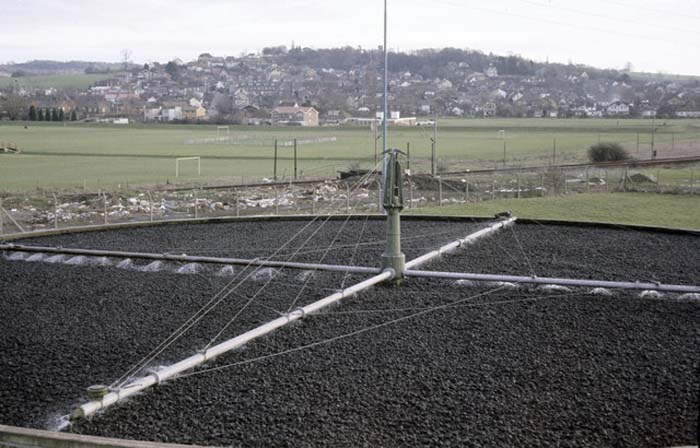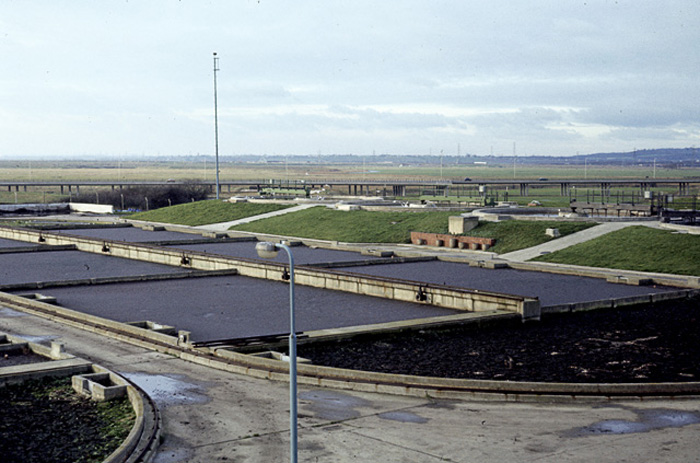
A sewage treatment plant is a facility that cleans and purifies wastewater before releasing it back into the environment. This wastewater can come from various sources, including residences, industries, and more. The main goal of a sewage treatment plant is to ensure that the treated water is safe to reuse or discharge. This is achieved by removing contaminants such as chemical contaminants, pathogens, and organic matter.
Components of the sewage treatment plant
Sewage treatment plants filter out harmful substances in wastewater and recycle the treated water back into the water cycle in a way that doesn’t harm the environment. A sewage treatment plant primarily comprises the following components:
Preliminary Treatment:
- Grit Removal
Removing sand, gravel, and other heavy solids decreases the risk of abrasion damaging mechanical equipment.
- Screening
Get rid of large objects like plastic, sticks, and rags that could disrupt operations or harm equipment.
Primary Treatment:
- Primary Sedimentation Tanks
They allow gravity to settle any suspended solids. The settled solids form primary sludge, while secondary treatment receives the primary effluent.
Secondary Treatment:
- Secondary Sedimentation Tanks
Consolidate the biomass, or biological solids, that have accumulated during the biological treatment process. Biomass that have settled are known as secondary sludge.
- Activated sludge process
When oxygen is present, aerobic bacteria decompose organic matter.
- Rotating biological contactors
Microbes break down the organic contaminants when discs spin through the effluent.
- Trickling Filters
Spraying wastewater over a media bed, where microbial biofilms settle, degrades the organic material.
- Biological Treatment Processes
This method uses microbes to break down organic waste in wastewater.
Tertiary Treatment:
- Disinfection
It uses ozone, ultraviolet light, or chlorine to kill any remaining bacteria or viruses.
- Nutrient Removal
Denitrification is the process of removing phosphorous and nitrogen from receiving waters to prevent eutrophication.
- Filtration
Use membrane filters, sand filters, or other techniques to rid the water of any remaining suspended particles.
Treatment and Disposal of Sludge:
- Disposal/Reuse
The last options for sludge disposal include landfilling, incineration, or land application. Other potential uses include agricultural biosolids made from treated sludge.

- Dewatering
It uses drying beds, belt filter centrifuges, or centrifuges to decrease the sludge’s water content further.
- Digestion
Anaerobic digestion typically breaks down organic matter, stabilizing the sludge.
- Thickening
It extracts less water from sludge, thereby decreasing its volume.
Additional Components:
- Disposal of Effluent
Systems enable the recycling of treated wastewater for industrial or irrigation purposes, and then release it into infiltration basins or surface waters.
- Control Systems and Instrumentation
There are automated systems for monitoring and controlling the treatment procedures.
- Smell Control
Smell reduction systems typically utilize biofilters or chemical scrubbers.
When combined, they guarantee efficient sewage treatment, which in turn protects environmental and human health.
Importance of a sewage treatment plant
Economic advantages, environmental protection, and public health are just a few of the many ways in which a sewage treatment plant is vital to modern civilization. To emphasize their significance, below are a few important points:
- Economic Advantages
- Compliance and Avoiding Fines
Proper sewage management can help municipalities comply with environmental requirements while avoiding sanctions and expensive fines.
- Tourism and Recreation
In addition to boosting local economies, clean waterways bring in tourists who enjoy boating, fishing, and swimming.
- Recovery of Resources
You can use reclaimed water from sewage systems for industrial and irrigation purposes. Additionally, you can turn biosolids into fertilizer and generate energy from biogas.
- Advancement of Science and Technology
- Education and Awareness
A sewage treatment plant’s common function is to educate the public about the importance of sustainable practices, prevent pollution, and conserve water.
- Innovation
The pressing need to improve sewage treatment drives technological advancements and research in fields such as biotechnology and environmental engineering.
- Protect the environment
- Nutrient Removal
Treatment can effectively eliminate dead zones by removing excess nutrients like phosphorous and nitrogen, which cause a lack of oxygen in the water due to toxic algal blooms.
- Biodiversity
Plants, fish, and other animals all benefit from ecosystems that have clean water.
- Quality of Water
By filtering out toxic substances, nutrients, and contaminants, a sewage treatment plant restores water quality and protects aquatic ecosystems.
- Sustainable Growth
- Reducing Climate Change’s Impact
Modern treatment technology can reduce the amount of greenhouse gases released by sewage, thereby helping to mitigate the effects of climate change.
- Urban Growth Management
By guaranteeing the sustainable management of wastewater from growing settlements, an efficient sewage treatment plant supports population growth and urbanization.
- Public Health
- Safe, Potable Water
By treating sewage before it contaminates natural water sources, we keep them safe for human use.
- Preventing Diseases
Treating sewage properly is one way to reduce the likelihood of waterborne diseases like typhoid, dysentery, and cholera. This helps eradicate harmful microbes and pathogens.
Types of sewage treatment plants
To control wastewater and make sure it’s safe to release back into the environment, sewage treatment plants are crucial. Engineers specifically design each type of sewage treatment plant to handle a unique combination of waste type, capacity, and treatment level. Therefore, the following are the most commonly encountered types:
- Primary Treatment Plants
This physically removes solids and large particles from sewage. This is the first step in primary treatment. Here are the primary steps:
- Skimming
Cleans the surface of any traces of grease or oil.
- Sedimentation
Heavier solids can occupy the bottom of the treatment tank as a result.
- Screening
Gets rid of bulky items like sticks and rags.
- Secondary Treatment Plants
The degradation of organic substances in sewage is the primary goal of biological processes used in secondary treatment. Here are some common methods:
- Oxidation Ponds
These are large, shallow sewage treatment ponds where microorganisms and natural processes take place.
- Trickling Filters
The process involves slowly releasing wastewater over a substrate coated with a biofilm that breaks down organic matter.
- Activated Sludge Process
Aerobic bacteria here facilitate the decomposition of organic contaminants.
- Tertiary Treatment Plants
The tertiary treatment produces an improved effluent. It uses sophisticated procedures to eliminate any residual pathogens and inorganic compounds. Methods comprise of:
- Disinfection
The process involves killing pathogens using either chlorine, ozone, or ultraviolet light.
- Chemical Treatment
Chemicals are added to precipitate and get rid of phosphorous nitrogen.
- Filtration
You can use membrane or sand filters to filter out the remaining solids.
Challenges and Innovations
Despite its importance for modern sanitation, a sewage treatment plant faces challenges such as managing emerging pollutants, energy consumption, and high operating costs. Wastewater treatment innovations are utilizing resource recovery systems, energy-efficient technology, and advanced biological processes to tackle these difficulties and make sewage treatment plants more sustainable.

- Package Treatment Plants
These small and self-contained systems are commonly used for individual facilities, remote areas, or small communities. They integrate primary, secondary, and even tertiary treatments as a single unit.
- Membrane Bioreactor Plants
Membrane bioreactor systems include both biological treatment and membrane filtration. The membranes prevent microbes and suspended particles from passing through, producing reusable, high-quality effluent.
Constructed Wetlands
These systems help to clean sewage in a similar way as natural wetlands. Soil, plants, and associated microbial populations eliminate pollutants through physical, chemical, and biological processes.
Oxidation Ditches
A lengthy, looping channel that uses aeration to cleanse wastewater. When it comes to removing nutrients and organic matter, this continuous flow system works wonders.
Anaerobic Digesters
Anaerobic bacteria break down organic materials in these systems, treating sewage sludge and creating biogas for energy. They work wonders when dealing with very strong waste.
Lagoon Systems
Microbes, algae, and sunlight all play a role in the natural treatment of wastewater in these vast, shallow ponds. They are affordable and work well in more remote places.
Sequencing batch reactors
Batch-based sequencing reactors help treat wastewater. They can handle changing loads with efficiency and flexibility by treating each batch in the same tank through a sequence of processes, including sedimentation and aeration.
Rotating biological contactors
Rotating biological systems partially immerse wastewater around a number of closely spaced revolving discs. The discs grow biofilm, which filters the wastewater as they spin in and out of the tank.
The wastewater’s characteristics and volume, as well as economic considerations, available space, and environmental regulations, are some of the criteria used to choose which sewage treatment plant type to install.
Conclusion
A sewage treatment plant is indispensable for protecting people and the environment. Its ongoing evolution and adoption of new technology greatly enhance resource conservation and sustainable water management.
